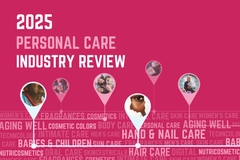BASF brings new skin testing tools and drives sustainable supply chains with AI

BASF presents advancements in sustainability and AI-driven technologies at the 34th Congress of the International Federation of Societies of Cosmetic Chemists in Foz de Iguaçu, Brazil.
From a new method for visualizing skin models to digital tools enhancing ingredient selection, the chemicals giant tells Personal Care Insights it is focusing on aligning science with consumer demands for sustainable personal care solutions. The company is also introducing its Surfactant Navigator and Emollient Maestro tools, designed to replace synthetic ingredients with biodegradable alternatives. It believes the tools represent BASF’s commitment to traceability and sustainable sourcing in beauty formulations.
The German company plans to highlight sustainable hair care advancements too, featuring AI-driven solutions like natural anti-inflammatory peptides for soothing sensitive scalps and bio-based ingredients that restore hair health. It will present a digital tool that monitors the traceability of argan oil, ensuring fair compensation for producers while supporting responsible sourcing. Through its “Care 360°” approach, BASF seeks to promote sustainability across the personal care value chain, offering eco-friendly solutions without compromising performance.
We speak with Isadora Gabriela Alves Teixeira, chemical engineer and Personal Care marketing analyst and Dr. Oussama El Baraka, global responsible for Organoids & Hair Models to learn about the new tools.
Can you explain the current problem with the histological method for enhancing skin model visualization?
Baraka: Histological analysis of human skin is the standard approach to evaluating the morphology of this tissue. Nevertheless, if this method allows observation of tissue sections with a microscope, making 3D structure extrapolation of increasingly popular 3D skin models (such as spheroids, skin biopsies or reconstructed skin) is more difficult. These models represent a challenge in terms of their visualization because of their thickness and consequently their opacity. Without applying clearing, the data collection is partial and only corresponds to the periphery of the samples.
What advantages does BASF’s new high-resolution clearing histological method bring to research?
Baraka: The optical clearing coupling confocal microscope method was developed to increase both the probing depth of optical systems and the spatial resolution. This method allows one to characterize the entire structure/tissue. By adding well-chosen clearing steps, the robustness and reliability of any imaging analysis of 3D models could be greatly increased, and the results will better consider and represent the entire sample.
 BASF relies on digital tools to track supply chains that enable ingredient transparency.An optical clearing method coupled with confocal imagery could be applied in cosmetic research for the microdissection of very complex structures such as sebaceous glands or vascular networks, allowing for a better understanding of skin structures and their variations and for ingredient screening purposes.
BASF relies on digital tools to track supply chains that enable ingredient transparency.An optical clearing method coupled with confocal imagery could be applied in cosmetic research for the microdissection of very complex structures such as sebaceous glands or vascular networks, allowing for a better understanding of skin structures and their variations and for ingredient screening purposes.
How do the Surfactant Navigator and Emollient Maestro tools help formulators create more sustainable and efficient products?
Teixeira: Our Surfactant Navigator tool provides customers with information regarding surfactants and surfactant mixtures. Based on systematic experiments and modeling algorithms, it helps them replace current surfactant combinations with more sustainable chassis without compromising performance. The predictions of the physiochemical, sensorial and thickening analysis will support customers in finding a more agile balance between the formulation’s sustainable properties and performance.
The Emollient Maestro is also based on systematic experiments and uses scientific models to predict physio-chemical and sensorial profiles of natural-based emollient mixtures. It supports customers in finding non-controversial combinations of emollients that can replace industry benchmarks such as cyclopentasiloxane, dimethicone or mineral oils. It thus allows for faster prototyping and more efficient product design with a positive sustainability footprint.
What role do BASF’s digital tools play in ensuring traceability?
Teixeira: Creating transparency on sustainability through digital solutions is one of our goals.
Nowadays, people are growing aware of their personal carbon footprint. To make informed choices, consumers desire detailed knowledge about the origins and sourcing of raw materials and are keenly interested in understanding a product’s effects on climate issues.
 BASF introduces an optical clearing coupling confocal microscope method.We are convinced that the industry’s transformation will continue to gather pace, and it is crucial for cosmetic manufacturers to stay ahead of increasingly stringent regulations while meeting consumer demands. By combining high-performing alternative ingredients with full know-how in formulation design and smart digital services, we can unlock solutions for the industry transformation together and really make a positive impact.
BASF introduces an optical clearing coupling confocal microscope method.We are convinced that the industry’s transformation will continue to gather pace, and it is crucial for cosmetic manufacturers to stay ahead of increasingly stringent regulations while meeting consumer demands. By combining high-performing alternative ingredients with full know-how in formulation design and smart digital services, we can unlock solutions for the industry transformation together and really make a positive impact.
How do digital tools contribute to promoting supply chain transparency and sustainability?
Teixeira: As part of its Responsibly Active program launched in 2022, a digital tool has been designed by BASF specifically to help monitor and track the supply chain of argan oil sourced from Morocco. This pilot project system helps monitor local sourcing by collecting detailed batch tracking data on the harvesting of the fruit, the crushing of the nuts and the processing of the oil, thus ensuring full traceability. The organic argan supply chain has already met high standards in the past and is fair trade certified. Now, the tool helps facilitate the certification process by providing easily accessible, reliable data, such as the contribution of income from argan activities to a fair living wage. It also benefits BASF’s local partners, highlighting their operational excellence and supporting oil-processing cooperatives in their digital transformation.
How do digital tools streamline replacing synthetic and non-biodegradable ingredients in formulations?
Teixeira: Digitalization enables industries to transform and accelerate sustainable innovation. At BASF’s personal care business, we use modeling, simulation and AI-based insights for our digital service platform D’lite. The platform is designed to support our customers in the product development process and includes several applications that help improve the sustainability of cosmetic formulations.












